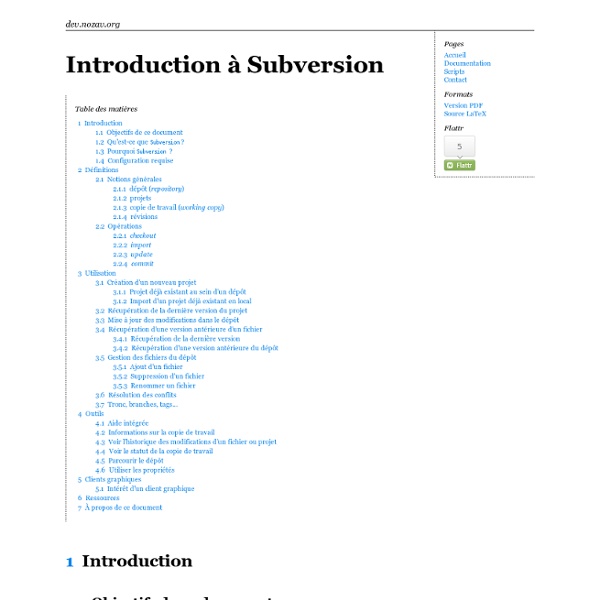FrRedmineInstall
Exigences¶ Système d'exploitation¶ Redmine devrait fonctionner sur la plupart des Unix, Linux, Mac et systèmes Windows aussi longtemps que Ruby est disponible sur ces plates-formes. Ruby, Ruby on Rails, RubyGem¶ Les versions de Ruby on Rails pour une version donnée de Redmine sont les suivantes : Base de données¶ MySQL 5.0 ou plus (recommandé) Assurez-vous d'avoir installé les liens C pour Ruby qui améliorent considérablement les performances. Composants optionnels¶ binaires pour les gestionnaires de version (SCM, par exemple: svn), pour la consultation des dépôts (doivent être disponible dans votre PATH). Installation¶ 1. 2. gem install bundler Après vous pouvez installer tous les gems requis avec la commande suivante: bundle install --without development test Si ImageMagick n'est pas installé sur votre système, vous pouvez retirer l'installation du gem rmagick avec cette commande: bundle install --without development test rmagick Note concernant l'installation de rmagick sur Windows: 3. 4. 5. 6.
" Installer un serveur SVN sur Debian" - CoolCoyote.net
Ce pense-bête a été fait à partir des deux articles suivants: Son but est de mettre en place un serveur subversion sur une Debian permettant la gestion de plusieurs dépôts avec une gestion des droits différente selon les dépôts. Installation des packages: > apt-get install subversion subversion-tools libapache2-svn Création du répertoire subversion: > mkdir /home/svn > chmod 770 /home/svn Création des différents dépôts (gestion multi-projets) > svnadmin create /home/svn/projet_1 > svnadmin create /home/svn/projet_2 On crée un fichier qui contient les utilisateurs / mots de passe qui auront accès au dépôt. > touch /home/svn/.passwd Ce fichier fonctionne pour la sécurisation d’un répertoire par htaccess. toto:$1$uH5.fe0.$4aTxZL9kZTHrjyemyJCBL1 hubert:$1$6I5.VG5. > vi /home/svn/.authz La syntaxe de ce fichier n’est pas extrêment compliquée.
Debian GNU/Linux :: Serveur :: Subversion
Serveur Subversion Matthieu Vogelweith 13 janvier 2009 L’objectif de cette page est de détailler l’installation d’un serveur Subversion [1]. Ce document a été rédigé en LaTeX en utilisant l’excellent Vim sous Debian GNU/Linux. Copyright ©2009 Matthieu VOGELWEITH <matthieu@vogelweith.com>. Vous avez le droit de copier, distribuer et/ou modifier ce document selon les termes de la GNU Free Documentation License, Version 1.3 ou ultérieure publiée par la Free Software Foundation ; avec aucune section inaltérable, aucun texte de première page de couverture, et aucun texte de dernière page de couverture. - principe - avantages - différences par rapport aux autres 1.1 Subversion vs CVS Subversion (SVN) est un système de contrôle des versions OpenSource distribué sous une licence compatible Apache/BSD. Subversion semble donc plus adapté que CVS, notamment au niveau de l’authentification (Apache donc PAM, NIS, ...) et de la gestion des versions sur l’arborescence du dépot. 3.1 Création des dépots
Apache2 & dav_svn (Page 1) / Serveurs
Bonjour à tous , J'ai installé classiquement un serveur apache2 avec les modules php5 et libapache2-svn afin de pouvoir accèder à mon repository svn à partir du protocole http. Dans un premier temps , j'ai également installé websvn à partir des sources ( et non par apt-get ). Du côté webSVN tout fonctionne correctement , mais ce n'est pas le cas lorsque je tente d'accèder au repository svn à partir de Web Dav. Le fichier error.log d'apache : [Thu Feb 19 08:00:02 2009] [error] [client 213.213.253.23] File does not exist: /var/www/svn Le fichierdav_svn.conf : Je ne comprend pas par quel "magie" celui-ci tente d'accèder à /var/www/svn alors que dans la conf, je n'y réfère pas ce path. Une autre question à part , j'ai remarqué également dans mes logs que j'avais toutes les 5 minutes l'erreur suivante : [Thu Feb 19 07:56:07 2009] [error] [client 82.196.209.37] client sent HTTP/1.1 request without hostname (see RFC2616 section 14.23): /w00tw00t.at.ISC.SANS.DFind:) En vous remerciant d'avance
subversion
Installation Toute installation de SVN nécessitera l'installation du paquet subversion Une bonne base pour les futurs dépôts ("repository") est /var/svn : sudo mkdir /var/svn C'est dans ce dossier que vous créerez vos futurs repository. Nous considérerons cette base pour la suite de la documentation. Configuration SVN peut être installé de plusieurs façons : Seul, en local, l'accès au dépôt se faisant par seul, en mode serveur, c'est-à-dire que l'accès au dépôt SVN sera sous la forme , avec des utilisateurs SVN créés à cet effet; ou administré via un module d'Apache (dav_svn), c'est-à-dire que l'accès au dépôt SVN sera sous la forme avec des utilisateurs créés pour le module dav_svn pour l'authentification. Dans les 2 derniers cas, dans l'adresse d'accès à un dépôt, mon_serveur/ représente la base des dépôts. Serveur SVN seul Tout d'abord, créez un dépôt (nous considérerons le répertoire projet1). Lancer le serveur Accès #!
svn : branches, tags, trunk et pourquoi pas sangoku ? - Particul.es blog
Un post très rapide pour gérer son repository svn d'un projet. La vanne foireuse de mon titre est une phrase que je me suis dit la première fois que j'ai vu un repository svn. Au final cela ne demande pas grande connaissance quelques commandes et de la logique. Organisation du dépôt On crée le dépot rep , on fait un checkout de celui-ci dans une copie de travail "work", puis on crée les 3 répertoires de notre organisation. ioo@particules:~/test$ mkdir rep work ioo@particules:~/test$ svnadmin create rep ioo@particules:~/test$ svn co work/ Révision 0 extraite. ioo@particules:~/test$ svn mkdir work/branches work/tags work/trunk A work/branches A work/tags A work/trunk ioo@particules:~/test$ svn ci -m "mise en place svn" work/ Ajout work/branches Ajout work/tags Ajout work/trunk Révision 1 propagée. Bien évidement si votre projet ne va pas durer, même pas besoin d'un trunk, mais bon pour l'exemple, imaginons que vous vous lancez dans un framework [ 1 ]



